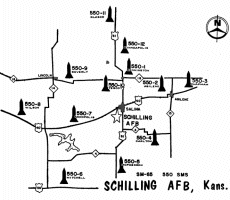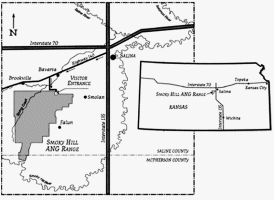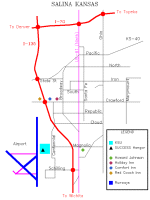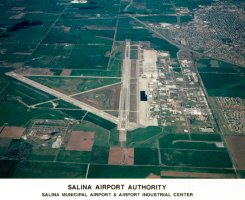Schilling Air Force Base, Kansas
Schilling Air Force Base in Salina, Kansas, home to the 310th Strategic Bombardment Wing [also designated the 310th Strategic Aerospace Wing] flying B-47s and the 22d Strategic Aerospace Division, ceased operations in 1965. A portion of the property once occupied by the base has been partly transferred to the Salina Airport Authority (SAA) through a base redevelopment plan and is operated as the Salina Municipal Airport.
The construction of airfields during World War II resulted in the construction of the Smoky Hill Army Airfield on 2,600 acres, southwest of the Salina urbanized area. Construction began in May of 1942 with the aid of nearly 7,000 construction workers. The first B-17's arrived in September of that same year. In September 1943 the 20th Bomber Command and the 58th Bomber Wing moved to Smoky Hill Army Airfield, and they were later joined by the 73d Bomb Wing. The B-17's were eventually replaced with B-29's and the base was used as a processing and staging area for heavy bombardment units going overseas. Upon completion of WWII, the base was home to 45 B-29's and 20 tanker planes of the 301st Bombardment Wing.
The Strategic Air Command's 97th Bombardment Wing was based at Schilling Air Force Base during 1946 and 1947, equipped with B-29s. By 1947 the 97th and 301st bombardment wings of the Strategic Air Command, flying B-29s were based at Smoky Hill AFB. The 22nd Bombardment Group (Very Heavy), equipped with the B-29 Superfortresses, moved from Kadena Air Base Okinawa to Smoky Hill AFB, in May 1948. The 22nd Bombardment Wing shared its commander with the 301st Bombardment Wing until the 22nd moved to March AFB on 09 May 1949. The name of the base was changed to Smoky Hill Air Force Base in January of 1948. The Defense Department deactivated the base in August of 1949, with the 301st being relocated to another Air Force Base.
In 1951 the Department of Defense reopened the base as a prestigious Strategic Air Command Base. By 1952 the B-29s of the Strategic Command had again begun to operate from Smoky Hill, and Strategic Air Command's 802nd Air Division was formed in May of that year. And by early 1954 802d Air Division was at Smoky Hill. The 40th Bombardment Wing, initially equipped with B-29s, received sleek new jets to replace the obsolete B-29s in 1954. During its first flight on 17 December 1954 -- 51 years to the day after the Wright Brothers flew for the first time at Kitty Hawk, North Carolina, the 1000th Boeing-Wichita B-47 took off, bound for Smoky Hill. In Salina, home of the 802nd Air Division, Number 1000 was christened the "City of Salina." By 1955 the Wing had completed conversion to B-47s, and was flying KC-97 tankers. In 1955 the base was named a "Golden Anniversary of Flight Base" primarily as a result of good base-community relations. The 310th Bombardment Wing at Smoky Hill Air Force Base won top honors in SAC's 1956 bombing evaluation exercises.
On 16 March 1957 Smoky Hill Air Force Base was redesignated Schilling Air Force Base. Colonel David Schilling was a fighter pilot with 23 kills against the German Luftwaffe. More than any other American officer he was responsible for the development of aerial refueling techniques for fighter aircraft. He was killed in an automobile accident near Mildenhall, England on 14 August 1956.
In 1959, the Department of Defense began a major renovation of the base and also began construction of the 12 silo intercontinental ballistic missile complex. During the next year, millions of dollars were spent preparing the runways and taxiways for the next generation of bombers and tankers, namely the B-52 and KC-135. Overall spending at the base during this era amounted to $250 million.
The 45th Bombardment Squadron at Schilling transferred to Forbes Air Force Base, Kansas in June 1960. Beginning in August 1960 the Site Activation Task Force at Schilling Air Force Base, constructed and turned over to the Strategic Air Command the first operational Atlas F hardened silo missile squadron. Schilling was turned over to SAC’s 550th Strategic Missile Squadron on 7-8 September 1962.
Originally there were to be nine Atlas silos located around Schilling; however, the number increased to a dozen individual sites located at or near Bennington, Abilene, Chapman, Charton, McPherson, Mitchell, Kanopolis, Wilson, Beverly, Tescott, Glasco, and Minneapolis.
In the wake of Defense Secretary McNamara’s May 1964 directive accelerating the deactivation of the first generation ICBMs, SAC inactivated the squadron in June 1965. With the closing of Schilling AFB, responsibility for the sites passed to F.E. Warren AFB, Wyoming, in July 1967. The sites were disposed of in March 1971.
On 19 November 1964, the Department of Defense announced that Schilling along with 574 other bases around the world would be closed. At this time the base was home to approximately 5,090 men. Within the next six months, all planes and men were relocated, including the Atlas F ICBM Squadron, and the base was closed on 30 June 1965.
The City of Salina worked hard at formulating a plan that would lessen the economic blow to the community of the closed base. The newly created Schilling Development Council announced plans for an airport-education-industry complex to replace the military operations. Special enabling legislation allowed the City to acquire, own, maintain, operate, improve and dispense with portions of the base. By May of 1965 the Salina Airport Authority had been created and the conversion of Schilling Air Force Base to the Salina Municipal Airport and Salina Airport Industrial Center began.
As with many formerly used defense sites, communities are anxious to redevelop the land. An obstacle often faced by communities is existing contamination of the property. At Schilling, contamination associated with USTs needed to be addressed. To eliminate risks posed by underground storage tanks (UST) and to meet a need to expand onto the property, the U.S. Army Corp of Engineers (COE) used an informal partnering approach to accelerate the cleanup at the former Shilling Air Force Base.The initial phase of the investigation revealed that the project involved much more than a "routine tank pull." The work involved is quite complex because it requires removing 36 large, 50,000-gallon USTs at an active airport, all of which must be conducted in strict accordance with Federal Aviation Administration regulations. Partnering allowed the COE to substantially reduce costs and surpass its environmental restoration schedule by one and a half years.
In 1973, the Kansas Air National Guard assumed all operating and maintenance authority for the the 34,000 acre Smoky Hill Air National Guard (ANG) Range. The Range, which is maintained and operated by personnel of the 184th Bomb Group, Kansas Air National Guard, is located ten miles south of Salina Kansas, in the rolling grasslands of the Smoky Hills. The 184th Bomb Group's mission is to maintain the peace by providing the best air tactics training environment possible. To carry out this mission, the guard employs 24 full time Active Guard Reserve personnel and two civil service employees. This full time contingent is supported by Air Guardsmen on weekends. In addition to meeting its military mission, the 184th carefully manages the natural and cultural resources of the Range, protecting the environment and providing recreational opportunities, as well as generating revenues from agricultural leases.
Smoky Hill ANG Range is the largest of 15 bombing ranges in the Air National Guard. Within Smoky Hill's 34,000 acres lies a 12,000 acre target area which is comprised of dual conventional ranges and three large tactical ranges. The tactical ranges provide the most realistic air-to-ground training available for all types of military aircraft. Smoky Hill also has four drop zones for cargo aircraft.
The earliest known European explorer to visit the Saline River country was the Frenchman Etienne Veniard de Bourgmont who crossed through present day Saline County, Kansas, in 1724. Captain Zebulon Pike met with the chiefs of the Kansa and Osage tribes to arrange a peace treaty, as well as to establish friendly relations with the Comanche. He was also on the lookout for information on the natural environment, streams, mineral resources and the people of the southern portion of the Louisiana Purchase. On the way to a large Pawnee village on the Republican River in Nebraska, Pike's expedition passed only a few miles to the east of the Smoky Hill ANG Range. Later, when his expedition headed west, Pike and men were captured and imprisoned by the Spanish in Santa Fe, eventually being released in l807. Following Pike's expedition and prior to the Civil War, the Saline River country was inhabited primarily by Indians, hunters and trappers. In 1854, passage of the Kansas-Nebraska Act by the United States Congress spurred interest in the settlement of Kansas. From the 1850s to the 1880s, the settlers in Saline County lived in either earthen dugouts or sod houses. The arrival of the railroad in 1867 dramatically stimulated the development of Salina County. The population swelled to over 2,000 in a matter of months.
The life of the area changed dramatically in 1942 with the announcement that the government needed their farms for the construction of Camp Phillips, one of a number of 35,000 man training camps established around the country following the start of the Second World War. Over 42,000 acres or 72 square miles were taken for the base. Camp Phillips was deactivated in October, 1944, when it was clear that the end of the war was in sight. The base was dismantled and the land either leased or sold back to the original owners by 1946.
The western part of the camp was used briefly as a gunnery range by Army Air Corps pilots stationed at the Smoky Hill Air Field, named for the river which wanders through Salina. The Smoky Hill Air to Air Gunnery Range encompassed approximately 218,384 acres. The majority of the range was in the southwest quarter of Gove County, but it extended to the west into Logan County, and to the south into Scott and Lane Counties. The terrain varies from rolling hills to steep canyons. Near where the Smoky Hill river crosses the Logan/Gove county line, numerous large formations of fossil laden chalk rise from the plain. These are referred to the Chalk Mountains--supposedly one of the targets.
The Army Air Force acquired this land in 1943. Aircraft primarily from
Smoky Hill Army Air Field used the air space above the ground for gunnery practice, shooting at targets towed behind other planes. A clearance certificate dated 16 September 1947 stated, "all decontamination at Smoky Hill ATA Gunnery Range, Kansas, has been completed..." Several locals have found .50 caliber shells, bullets, and cartridges, and 20mm casings and cartridges; although all documentation found states that only .50 caliber machine guns were used over the site. Apparently, the 20mm was a British round which was being tested on this range. Also found by local fossil hunters, have been cannon ball fragments dating back to the 1800's. Many .50 caliber and a few British 20mm cartridges, shells and links have been found throughout the area by farmers and fossil hunters. The remoteness, current use and the ammunition items involved present very little hazard to the public.




Read details about the Atlas Missiles at Schilling AFB here.